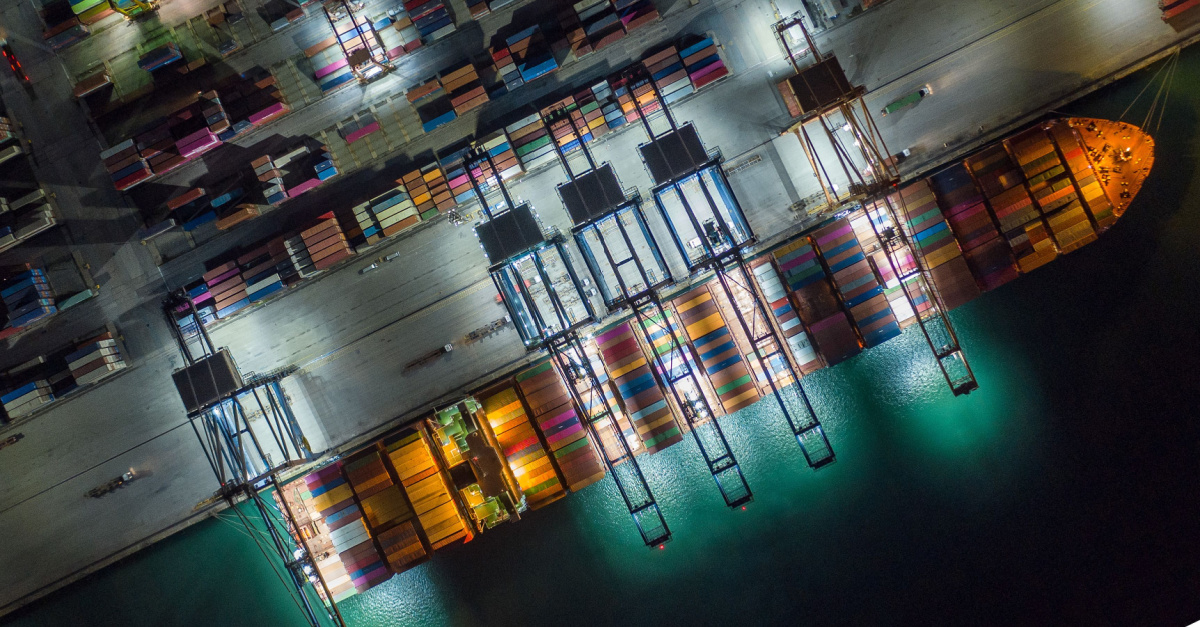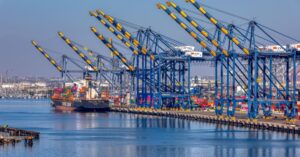The volume of freight on the ocean may ebb and flow a bit, the price of bookings may rise and fall, and disruptions may raise their ugly heads. But regardless of the market picture or the actions of a band of terrorist agitators in the Red Sea, freighters continue their thousands of annual sailings in support of commerce and trade – making enhanced ocean freight tracking indispensable.
As is readily apparent, managing freight transportation in this major channel requires a great degree of coordination and planning between shippers, freight forwarders, brokers, and carriers. This is especially true if you’re looking to achieve the grail of seamless port-to-door logistics for all of your importing.
To make this happen and take the worry and anxiety out of it for shippers – with business success or failure dependent on so many factors that ride along with their cargo – companies need a reliable broker partner. An experienced broker can oversee the entire process from pickup at the port to the shipment’s final destination. At every step, they can provide timely updates and shipment visibility to address any unforeseen issues that may arise.
The Anchors of Anxiety in Ocean Freight
Those issues come in many forms, which can pop up in a variety of ways, both large and small. One common denominator to all of them: they lead to costly delays rippling out across your business operations, upsetting customers and causing hiccups in manufacturing, sales, and other key functions.
To cite one recent example, a Maersk ship lost dozens of containers in December 2023 during a storm in the North Sea. Cargo washed up on Danish beaches, and floating debris posed a navigation hazard to other vessels.
A much larger ocean freight disruption has come in the form of Iran-backed Houthi rebels in Yemen. It has played havoc in the Red Sea, threatening vessels transiting the major east-west waterway, which handles 30% of global container traffic. According to the Freightos index, ocean freight rates for Asia to Northern Europe were up 461% as of Jan. 23, compared to mid-October, before the attacks began. Diversion around the Cape of Good Hope has risen rapidly, causing weeks of delay.
The Panama Canal is another issue. Ongoing drought conditions caused a backlog through the passage for much of 2023 and could cost the canal authority up to $700 million in 2024. Some shippers have diverted volume onto rail to get across the isthmus separating the Atlantic and Pacific. Still, the situation is improving, especially for retail shippers with initial booking priority.
Aside from those major disruptions, a lack of visibility into ocean freight shipments is an issue plaguing many shippers. Not knowing your cargo’s exact location and status is a huge frustration.
One issue complicating visibility is transshipment, i.e., the transfer of a container from one vessel to another, and possibly a third, before reaching its destination port. About 40% of all cargo shipments pass through container ports. This makes it important to have container-level tracking available on each shipment.
Shippers also need to have ocean freight tracking of vessels as well. To enable this, you need to have visibility into how many ships are heading to the same port and how many of them will reach it sooner than the one containing your cargo. This is how port authorities determine berthing order, i.e., which ships are cleared to tie up at what pier and when. Like so many other aspects of logistics, algorithms can predict berthing order and thus determine more accurately your shipment’s arrival time.
There’s a complex welter of documentation to file, manage, and keep track of on every inbound ocean freight shipment. There’s the bill of lading, essentially a contract between the importer and the carrier, both negotiable (goods can be sold while in transit) and non-negotiable. The commercial invoice is a bill for the goods from buyer to seller, which customs authorities use to assess valuation to determine import tariffs, duties, and fees.
A certificate of origin verifies where the goods are coming from to help customs inspectors determine they’re not produced in a restricted country. If the cargo is moving among countries in North America, a NAFTA (North American Free Trade Agreement) certificate of origin is required.
Other types of import documentation include an insurance certificate, an export declaration, a Destination Control Certificate (designating which countries the goods can be exported to), and a Shipper’s Export Declaration for merchandise valued at $2,500 or more.
The Inland Trek: Ensuring Smooth Transition from Port to Final Destination
Next comes the process of transferring cargo from a port to a carrier handling inland transportation, a.k.a intermodal logistics. Once containers are unloaded from the ship, they’re transferred to the terminal yard. From there, drayage carriers shuttle in and out to ferry loads to a railhead or a trucking depot once the goods have cleared customs.
For that process, the importer or their broker submits various forms of documentation to customs officials for review and clearance to ensure compliance with import regulations. To say that all the I’s need to be dotted and T’s crossed at this stage is a huge understatement. Regulatory requirements for customs and importing are updated on a regular basis, and expertise is needed to make compliance happen and avoid delays.
After customs declaration (in which import duties, fees, and taxes are assessed) and entry are completed, and the customs bond is verified, the shipment is cleared for inland transit.
All of this requires a high degree of coordination and timing to orchestrate the movement of freight a short distance from the ship to the inland carrier. Port congestion can cause roadblocks at drayage. There can also be a shortage of chassis for trucking the shipments to the rail or road carrier, a frequent occurrence during disruptive events. Security and customs inspections can delay processing and getting goods on their way.
Once these hurdles are cleared and the freight is moved inland, route optimization for transportation to the final destination becomes vital. Visibility into your freight’s location continues to be a significant factor as well, to accurately determine – and often update – expected arrival time as it moves along the various hops and legs of the journey.
Navigating with Advanced Ocean Freight Tracking Technology
Let’s follow the path of an imaginary shipment of computers from a plant in Shenzhen, China’s Silicon Valley, bound for a retail distribution center in Chicago. It’s shipped by truck to the port there, loaded into a container at a terminal, and put onto an ocean freighter. It then sails northeast to Busan, South Korea, where it is transshipped onto another vessel for trans-Pacific passage to Los Angeles. It’s offloaded, short-hauled by drayage to a nearby rail yard, and bound for Chicago. Once there, it’s conveyed once again to a company warehouse for breakbulk and palletization, then short-hauled by truck the final leg to the distribution center.
With all of these handoffs, loading and unloading, and breakdown – not to mention customs clearance and Department of Homeland Security inspections – there are multiple points of failure for a standard tracking system. That may work fine for the ocean transit piece, with most carriers providing sensor-and-tag-based status updates, but not for the entire port-to-door journey.
COGISTICS Transportation, with a 30-plus-year heritage in global logistics, has an advanced tracking system that provides visibility of each shipment from port to door. You can access updates across each stage of your cargo’s journey through data connections to ocean and land carriers, ports, and terminals.
Collaborative Communication: The Crew Behind the Curtain
COGISTICS Transportation has an experienced team that provides an integrated communications solution to keep you informed every step of the way. Through a combination of high tech and high touch, including good old-fashioned phone calls and digital channels, COGISTICS Transportation informs you of your service options as well as shipment status and potential pitfalls.
COGISTICS Transportation communication platform provides shippers with critical, timely information to inform decision-making should issues arise that call for preemptive action. For instance, real-time updates on port congestion issues in Los Angeles due to a work stoppage can lead to a diversion to another West Coast destination via transshipment.
Data Analytics and Customized Reporting
COGISTICS Transportation utilizes data analytics to enhance service delivery, visibility, communication, and compliance for ocean freight shipment and importing. A digital freight forwarder, it uses an array of modern tools, including the Internet of Things (IoT), cloud computing, data analytics, and machine learning.
All required paperwork, including customs documentation, bill of lading, and commercial invoice, is captured as data points, translated into systematic updates, and transmitted directly to partners. The COGISTICS Transportation dashboard provides easy access to things like shipment status and location.
Customized reports driven by data analytics empower shippers to plan more effectively and respond quickly to disruptive or delaying events. COGISTICS Transportation integrates seamlessly with enterprise systems such as ERP and CRM for auditing and management purposes.
Cloud Deployment
COGISTICS Transportation’s cloud-based platform can be accessed from anywhere, so shippers can access all essential documents and information remotely, enhancing mobility and flexibility. It can also be shared with partners and stakeholders, enabling greater cooperation, visibility, and accountability.
Take the Worry Out of Ocean Freight Tracking
Ocean freight logistics can stray into turbulent waters, literally and figuratively, with common challenges such as various disruptions, lack of visibility, and complex documentation, causing delays – and undue anxiety.
COGISTICS Transportation’s advanced tracking technology, collaborative communication, and data analytics can transform the shipping experience from a stormy ordeal to a controlled, smooth sailing adventure. Our comprehensive tracking systems and dedicated team provide shippers with a more reliable, transparent ocean freight shipping process, from booking to delivery. Get in touch with us today!




